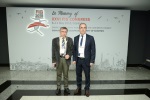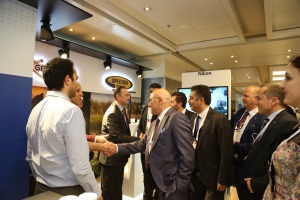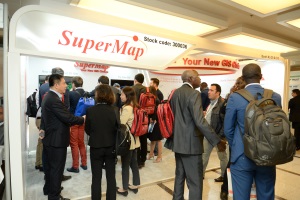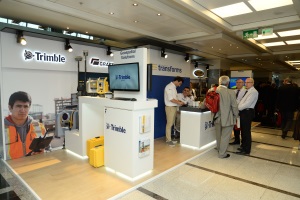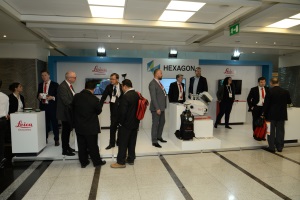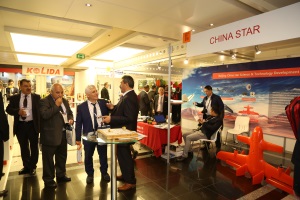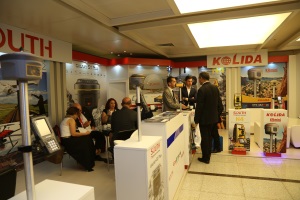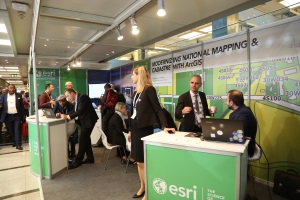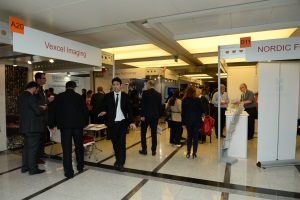News in 2018

|
FIG Congress 2018 Report
6-11 May 2018, Istanbul, Turkey
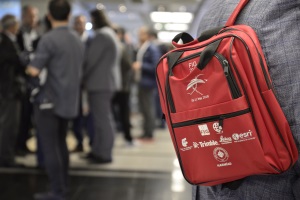
Welcome to the FIG Congress 2018 |
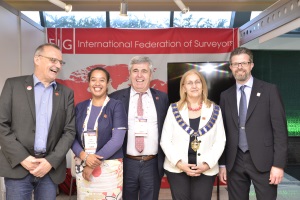
On the last conference day all participants could meet FIG
Council and the FIG stand in the exhibition
|
The large 4-year FIG Congress took place in the beautiful city of
Istanbul. The Congress marks the end of the term of leadership and the
in total 6 days were packed with the General Assembly, technical
sessions, meetings and many other activities. The congress attracted
more than 2300 participants, coming from around 90 countries from all
over the world. The Turkish representation was remarkable, and FIG was
pleased with the large support from both national and international
sponsors, organisations and individuals.
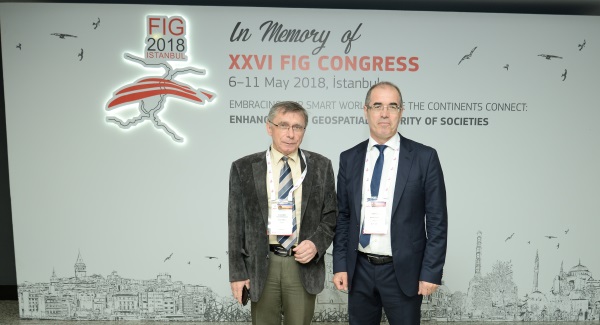
The "memory wall" was a popular place for photo
shootings and as meeting point durign the Congress
Technical programme
Over the 4 conference days the technical programme was packed with sessions and meetings with
more than 400 paper presentations and several special sessions that
covered the whole range of topics within surveying. The overall theme:
Embracing our smart world where the continents connect:
enhancing the
geospatial maturity of societies
reflected many of the sessions and presentations within the areas of
all 10 FIG Commission topics:
- Professional Practice
- Professional Education
- Spatial Information Management
- Hydrography
- Positioning and Measurement
- Engineering Surveys
- Cadastre and Land Management
- Spatial Planning and Development
- Valuation and the Management of Real Estate
- Construction Economics and Management
Pre events
In connection with the congres there were three pre-events
- Reference frames in Practice Seminar
- BIM for Surveyors Seminar
- Young Surveyors Conference
The Reference Frames in Practice seminar was held
over two days. The main focus was on reference frames in general,
kinematics and dynamic datums which reflects geodetic priorities for all
regions suffering from natural disasters such as earthquakes. Most of
the participants came from countries where there is a strong need to
model deformation to maintain their accurate spatial reference frames.
Report, photo gallery and proceedings
BIM for Surveyors Workshop was also held over two
days and with great success. The around 50 participants spent the first
day with sessions on BIM and a special tour was organised for the second
day to Istanbul New Airport. This tour was a real special experience for
the participants.
Proceedings and photo gallery
Young Surveyors Conference also attracted many participants who spent
the first day in a great and inspiring learning environment. The second
day offered a treasure hun around Istanbul and a discussion on the
future of the FIG Young Surveyors Network.
Programme
This year, the Young Surveyors had organsied a Charity Dance. This
took place at the end of the seond day of the Young Surveyors Conference
- and was held at a time so that other congress participants, incl. all
those who attended the General Assembly could also participate. While in
Turkey - learn to dance Turkish..., and many took up this challenge and
had a fun and great time learning the
“Horon” which is a Regional Folk Dance which is a very moving and
swift dance style. Horon symbolizes the waves of the sea, the pouring of
the rain and the struggle against nature.
The donations from the participants of the charity dance went to the
local Humanitarian OpenStreetMap Team Local Community “Yer
Çizenler Herkes İçin Haritacılık Derneği" and FIG
Foundation.
Opening ceremony and plenary sessions
The grand opening ceremony took place in the large auditorium of
Istanbul Congress Centre, and the audience experienced a very talented
teenage dance company from Ankara.
A beautiful start of the Congress.
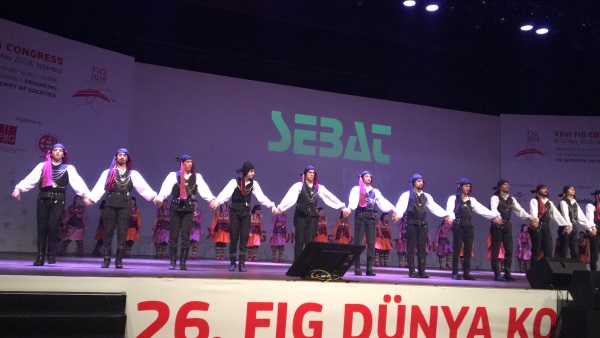
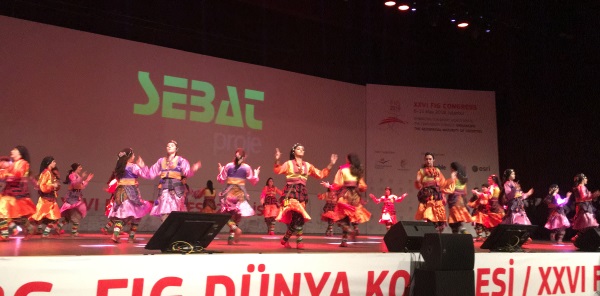
After the national anthym and the traditional FIG Fanfare an
impressive video was presented showing the multitude and magnitude of
what surveyors are doing. After this spectacular start of the Congress
Mr Orhan Kasap President of the host association, the
Chamber of Surveying and Cadastre
Engineers of Turkey greeted the more than 2300 participants who have
found their way to Istanbul and to the Congress. Mr
Ertuğrul Candaş who has been President of the Chamber since the General
Assembly in 2014 elected Istanbul, Turkey as destination for the FIG
Congress 2018, welcomed everyone to Turkey in a well-formulated English.
Finally, Dr Orhan Ercan, Co-Congress Director for the FIG Congress 2018
went to the stage - happy to see all the many attendees after four years
of preparations.
FIG President Chryssy Potsiou held her welcome address and thanked
the local organisers for their hard work on the preparations during
these four years. Four years is a long time - but they go fast when such
a big event is being prepared. President Potsiou also had a special
greeting to those
who attended for the first time and encouraged them to participate in
FIG.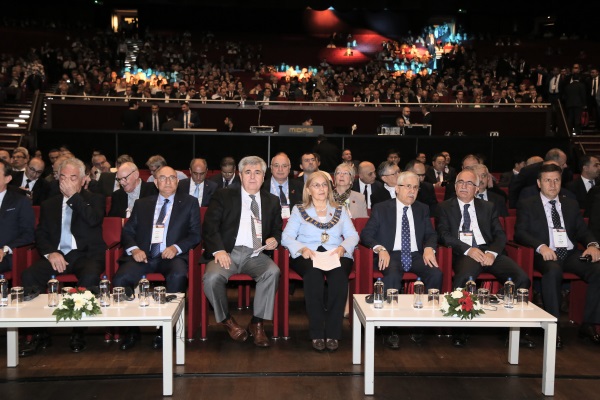
Finally it was an honour that Prof. Dr. Mustafa Öztürk,
Undersecretary at Turkish Ministry of Environment and Urbanization
attended in the opening and gave a welcome address to both the national
and international participants. The overall theme of the Congress:
Embracing our smart world where the continents connect:
enhancing the
geospatial maturity of societies is of importance both
for Turkey and also Internationally. At the end of the Opening Ceremony
the exhibition, that was found in the large hallways, was opened, and
the honoraries walked apst the many international and national stands.
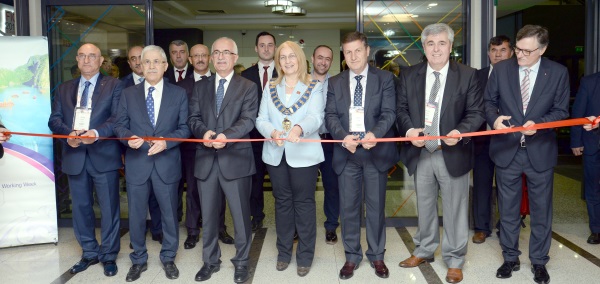
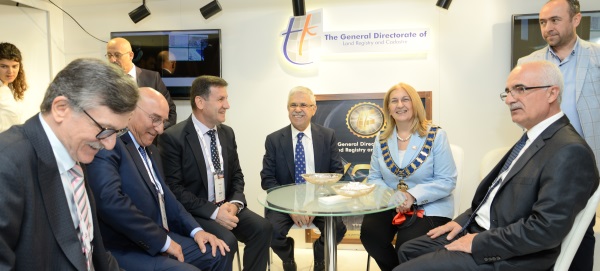
The first plenary session with the overall theme
Urban Development was chaired by Ms Oylum Talu, a popular Turkish
television presenter. She guided the three plenary speakers through an
inspiring plenary session with questions and comments. First speaker was
FIG President Chryssy Potsiou. Since it is her last year in the chair
she gave a summary of the FIG achievements during her term 2015-18. Dr.
Mustafa Palancıoğlu, Mayor of Talas, Kayseri was the second speaker of
this session (replacing Mr. Mehmet Özhasekí, Minister, Ministry of
Environment and Urbanization who was unfortunately not able to attend
due to the upcoming elections in Turkey) talked abou the Urban
Regeneration Process in Turkey. He said that due to the fact that cities
in Turkey are cituated in an earthquake zone there is a need to build
safer. In the latest 75 years more than 60,000 lives have been lost due
to earthquakes. This means that around 350,000 houses need to be
reconstructed due to the new law of regeneration which causes extremely
high costs. A 6 step implementation plan is used which also gives room
to plan more social urban welfare and public areas. Prof. Ali Parsa,
Dean of the School of Real Estate and Land Management at Royal
Agricultural University was the last speaker in the session talking
about The Fourth Industrial Revolution and impact on Urban Development:
the Role of Real Estate. The number of world population that live in
cities has grown immensely since the 1950'ies and this trend is supposed
to continue reaching an urban population of 6.4 billion (out of around
9.6 billion) by 2050. He explained the Fourth Industrial revolution and
its game-changers and used Singapore as example of a smart city with a
long term vision. He made the audience think of the fact that today, the
top 6 companies in the world are internet based companies.
The second plenary session, themed Modern
Technology Usage for our Profession was opened by the first speaker Jürgen Dold,
President of Hexagon Geosystems. He talked about Transformation through
Digitalisation with numerous lively examples of what to expect for the
future at a digital level especially in connection with smart cities and
the smart use of smart data. Chair of FIG Commission 10 Dr SeeLian Ong
took over and talked about the new standard on construction ICMS and the
need for global consistency in measurement and in the reporting of construction
cost. A global standard is important in order to be able to benchmark
construction costs consistently and transparently. If it is possible to
talk the same construction-language all over the world it will be much
easier to cooperate. It was also important for the involved that the
standards should be simple (incl the language used) so that the
standards will be geninely understandable and usable. The work on the standards was
started in 2009 by six organisation, ICEC, PAQS, AAQS, CEEC, FIG and
RICS and was launched in 2017. The 2nd edition will be launched in 2019.
The third and final speaker was Prof. Charles K. Toth on Smart Cities -
the mobility component. He talked about the possibilities in positioning
and navigating for the infrastructure and traffic. There has been a
remarkable development in the driverless cars/transportation and the
technology behind, the use of big data to create smart scities, and what
smart mobility means to smart cities.
The third plenary session offered three
presentations on Rural Development, starting with Dr Michael Klaus,
Director of the Hanns Seidel Foundation (HSS) who talked on Rural
development for achieving the Sustainable Development Goals: Fostering
the Rural-Urban interrelationship. The previous two plenary sessions had
a focus on urban development - which has a big focus these days. The
rural development, though, is also of big importance and growth in
agriculture and rural sector of developing countries has a much greater
impact in reducing poverty and hunger than do urban and industrial
growth. The rural development is inevitable for attaining the UN
Sustainable Development Goals (SDGs). Dr Klaus elaborated over a new
rural development paradigm and the rural-urban relationship. Mr. Jawad
Peikar who is Chief Executive Officer Afghanistan Independent Land
Authority, ARAZI, GIRoA was second speaker in the session and talked
about the Afghanistan Institutional Development Program for Land
Administration - Learning from Best Practices: Towards a Sustainable
Land Administration System in Afghanistan. Afghan Land Authority has in
cooperation with the World Bank and government of Turkey worked on
modernizing its land administration that will lead to a modern
infrastructure for the land administration. By learning from the Turkish
experience it has been possible not to do pilots but to work on the
learnings from a tested land administration system. This development was
further elaborated upon at two special World Bank/FIG sessions. Prof.
Dr. Mehmet Babaoğlu, Member of Parliament Parliamentary Commissioner for
Agriculture, Forestry and Rural Affairs should have been the third
plenary speaker, but he had to cancel in the last minute due to the
upcoming elections, and when asked Mr Brent Jones, ESRI, took up this
challenge and managed to prepare a plenary presentation within very
short notice. A big thank you to Brent Jones who gave an interesting
talk about the Changing Landscape of Land Administration. He posed the
provoking question on how much can a robot take over the work of
different kinds of surveyors... A lot of information is already taken
over by computers, programmes, satelites etc and darge data samples can
be handled in real-time whereas previously data that was created was
already out of date when released. So, Brent Jones finalised his
presentation with another question: How do we stay relevant? and
presented "Brents seven rules for success"; think big and spatial; use
your tools; stay current; create new services; be free or affordable;
move quickly and evolve and finally get started now!
The fourth plenay that took place on the last
conference day had Spatially enabled societies as overall theme. FIrst
speaker was Keith Bell, World Bank talking about Fundamental
Infrastructure for Spatially Enabled Societies. He started his
presentation by noting that 2018 marks the 20 year anniversary for the
FIG publication
Cadastre 2014 written by the chair of the session and FIG Honorary
Member, Daniel Steudler,
and translated into 28 languages (this publication has been followed up
by the publication
Cadastre 2014 and beyond). The projected trends and vision of what
cadastral systems might be in 20 years time have proven true. Hereafter
he talked about the globel land and geospatial agenda and possibilities
within the sustainable development goals and the World Bank approach.
Challenges for the land agency governance are that substantial financing
is needed and that it is a monopoly commodity vulnerable to corruption.
A reliable cadastre is essential for property valuation and as base for
taxation. Prof. Abbas Rajabifard, UN-GGIM Academic Network took over
with a presentation on Spatially Enabled Societies and Smart
Communities. He pointed out that in order to get an interconnected
future for all there is a need for multidimensional land info and a
smart cadastre system stating that "Future is smart, connected and
sustainable". The final speaker was
Dr. Victor Khoo, Senior Deputy Director Singapore Land Authority (SLA)
whose presentation marked a end of the congress and was further to this
aa great wrap up of the
presentations from the previous days with his presentation on how
Singapore has worked towards a spatially enabled smart nation. Several
of the previous plenary speakers had used Singapore as example and now
the participants got an insight from closest hand in how this
development because such a success story and how it has worked towards a
smart, sustainable and resilient city of the future.
There are links to recordings of all plenary presentations in the
proceedings.
Technical sessions
The rest of the four session days were filled up with sessions that
were specially designed and sessions with presentations from the open
call for papers. Hereto there were a large number of workshops, meetings
and sessions with parners like UN-Habitat/GLTN, World Bank, UN-GGIM and
FAO. It is impossible to cover all areas, so have a look into the
proceedings.
General Assembly
A recond number of member associations attended the General Assembly
that took place 6 and 11 May. On 11 May 73 out of 105 member
associations were present representing in total 91 votes. The first
General Assembly was a day of presentations by the President on the
4-year achievements, the commissions, networks, permanent institutions
and task forces. The last part of the day was used for the nominees to
present themselves preparing for the votings that took place on 11 May.
On 11 May the traditional Presidents meeting was held and hereafter the
the votings that all were awaiting took place.

Presidents and Heads of Delegations at the Presidents meeting
Exhibition
Istanbul Congress Centre was the venue of the Congress. The large
hallways were used for the exhibition which meant that session rooms and
exhibition could all be on the same floor creating a dense and lively
traffic in the hallways. More than 50 exhibitors showcased their latest
news and products at their stands and some also took the opportunity to
make presentations at the stage in the exhibition area. Three of the
four FIG Platinum Corporate members, Esri, Leica and Trimble who were
also platinum sponsors at the congress, were offered a special session
in the technical programme which were all well visited. A huge thanks to
Esri, Leica and Trimble for their faithful contributions to the FIG
Conferences.
A large thanks also to the two main supporters The General
Directorate of Land Registry and Cadastre and T.C. Cevre V Sehircilik
Bakanligi as well as the Gold Sponsors Harmaid and Beylikdützü
Municipality, the Bronze Sponsor Sebai/Delair nd Basic Sponsor
Hi-target.
The impact of networking
A substantial part of the congress is of course the technical
programme where it is possible to gain new knowledge and get inspired.
Attending a FIG Conference is however a lot more. Networking is an
important part - this is where it is possibe to really discuss the
learnings, find people to ask and learn from, and to get contacts that
can last far beyond the conference. A conference is certainly also about
contacts and networking. The networking experience starts at the
Newcomers session which again this year was held right before the
Opening Ceremony. Evaluations from previous FIG Congresses and Working
Weeks have shown that around 1/3 or the participants are attending for
the first time. The Newcomers Session is a way to get acquainted with
FIG and also with other fellow-newcomers. Coffee breaks and lunches are
other places to meet and exchange as well as the Welcome Reception.
Further to this it was possible to attend a Traditional Turkish Evening
(FIG Foundation dinner, sponsored by Trimble), a spectacular dinner with
music and a possibility for all to join in the dance, and the Gala
Dinner that took place on a boat sailing on Bosporous. It was very
spectacular to sail up and down the beautiful coastline which gave an
extra dimension to the networking with many of the participants.
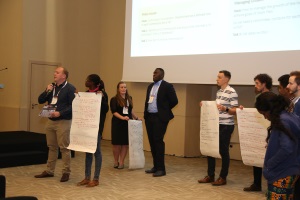 |
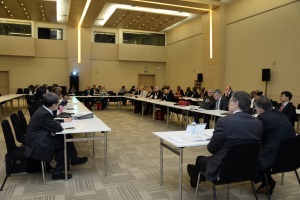
|
The technical sessions
were a mixture of the more traditional presentations, engagement,
groupwork and discussions.
Finally, a large thanks to the local organising committee who for
four years, since the Gneral Assembly in 2014 voted Istanbul as
destination for the FIG Congrwess 2018, have worked hard and very
dedicated to make this FIG Congress a huge success for all participants,
sponsors, exhibitiors, accompanying persons and partners. FIG would not
be able to carry through a conference without this work from the local
member association, and some very dedicated persons. A special thanks to
Co-congress Director Orhan Ercan for his tireless and efficient work
together with Prof. Muzaffer Kahveci, Mr Muhittin Ipek, Mr Harun Resit
Sever and Mr Ertugrul Candas, who was President of HKMO during the 4
years of preparations and also in the bidding process.
See you in Hanoi, Vietnam 22-26 April 2019 for the FIG Working Week.
"Good bye Istanbul, Turkey and FIG Congress 2018 and Welcome Hanoi,
Vietnam FIG Working Week 2019"
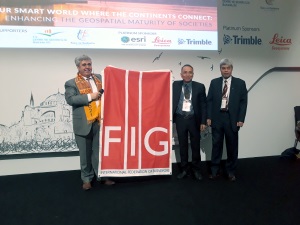
Co-congress Director Orhan Ercan, Turkey, hands over the FIG
Flag to Co-conference director Trinh Anh Co and President Tran
Bach Giang |
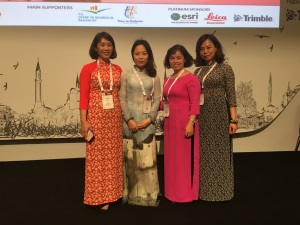
The local organisers
are waiting for you to visit Hanoi, Vitenam, and they will to their utmost to make the FIG
Working Week 2019 another unforgettable event
|
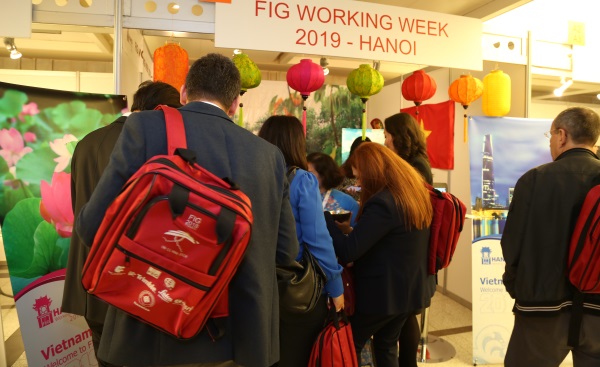
Further links:
Louise Friis-Hansen
July 2018























